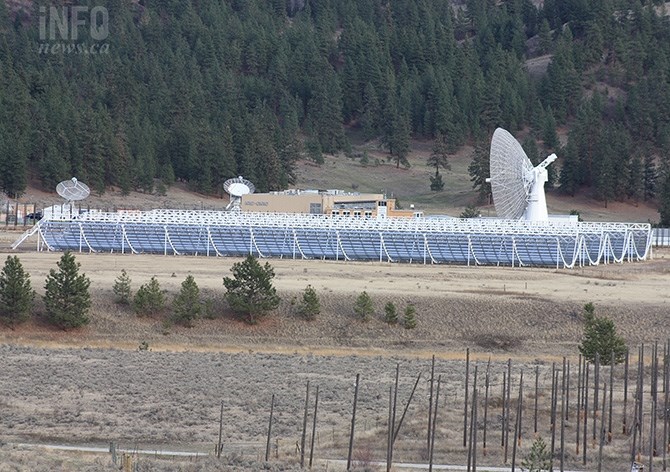
Dominion Radio Astrophysical Observatory's CHIME telescope is helping astronomers discover more about a fast radio burst first detected by the telescope in 2018.
(STEVE ARSTAD / iNFOnews.ca)
July 12, 2020 - 7:00 AM
The CHIME telescope at the National Research Council’s Dominion Radio Astrophysical Observatory south of Penticton continues to reveal new information about a space phenomenon originally discovered by researchers using the Okanagan facility.
The Canadian Hydrogen Intensity Mapping Experiment (CHIME) radio telescope at the Okanagan observatory first discovered what is known as a 'fast radio burst,’ or FRB, in 2018.
The latest findings of a Canadian-led team of astronomers, including McGill University researchers, recently discovered the repeating fast radio burst (FRB) actually pulses at regular intervals, apparently every 16.35 days.
European scientists earlier this year were able to pinpoint the location of this particular fast radio burst to a nearby galaxy located 500 million light years from Earth.
The research has since caught the attention of astronomers around the world who are now focussed on finding out what causes the fast radio burst to repeat.
The findings, published in mid-June, and described in a release from the McGill newsroom, indicates these fast radio bursts can repeat predictably.
“One of the most promising model possibilities for this phenomena is that of two stars orbiting around each other with one of them being a neutron star, a remnant of a massive star that undergoes a supernova explosion,” PhD student Pragya Chawla says.
McGill researcher Ziggy Pleunis says the fast radio bursts release in one-one thousandth of a second the same energy as that released by the sun over many years.
“We know this because FRBs come from far away, from outside the Milky Way galaxy we live in, so they must be very energetic for the radio light to be observable from so far away,” Pleunis said in an email.
The CHIME telescope studies this particular source of fast radio bursts for about 10 minutes every day. Pleunis says the telescope has no moving parts and scans the full sky overhead as the Earth rotates.
He says the telescope is also used to measure the expansion of the universe as well as study pulsars within the Milky Way galaxy, which are “some kind of cosmic lighthouse,” he says.
Pleunis says around 100 fast radio bursts have been detected so far.
“Most telescopes can only look at a very small portion of the sky at any one time, and that’s why only 100 have been detected so far,” he says.
Pleunis says the CHIME telescope is a "game-changer" because astronomers can now see a much larger part of the sky, allowing detection of several fast radio bursts each day.
“We have detected hundreds since we started operations near the end of 2018. We are currently analyzing our data before writing the result up,” he says.
To contact a reporter for this story, email Steve Arstad or call 250-488-3065 or email the editor. You can also submit photos, videos or news tips to tips@infonews.ca and be entered to win a monthly prize draw.
We welcome your comments and opinions on our stories but play nice. We won't censor or delete comments unless they contain off-topic statements or links, unnecessary vulgarity, false facts, spam or obviously fake profiles. If you have any concerns about what you see in comments, email the editor in the link above.
News from © iNFOnews, 2020